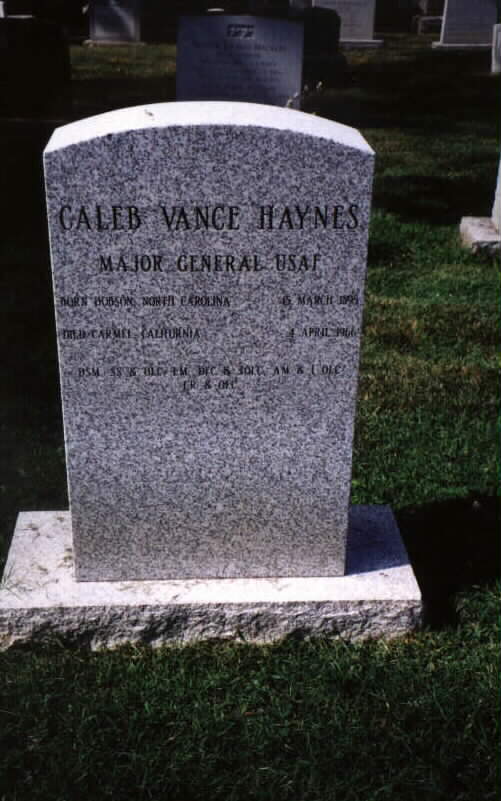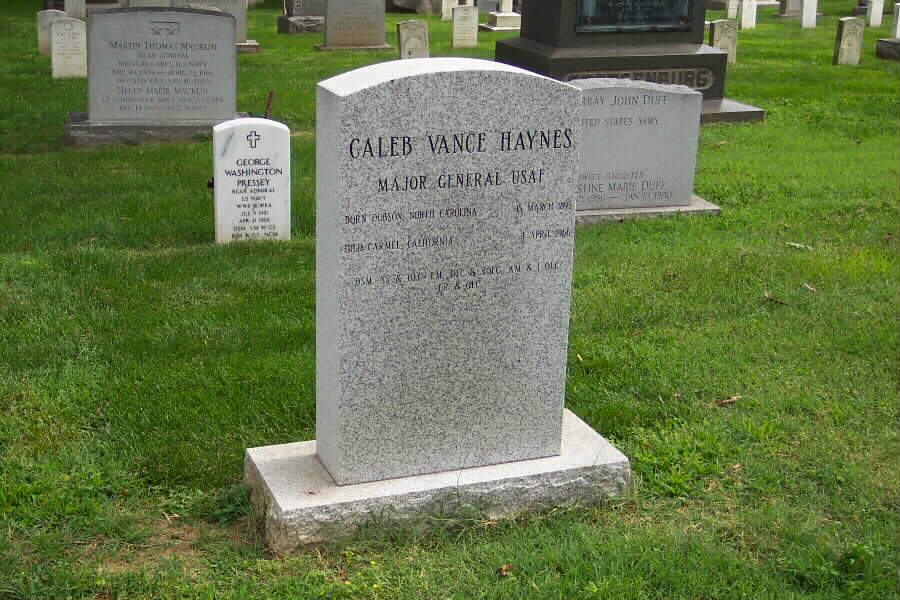Courtesy of the United States Air Force
MAJOR GENERAL CALEB V. HAYNES
Retired January 1953, Died April 5, 1966
Caleb Vance Haynes, Air Force veteran of both World Wars, and holder of ten military awards, was born at Mount Airy, North Carolina, in 1895. He graduated from Wake Forest College, North Carolina, in 1917 with a bachelor of laws degree, and a few months later entered the Army as a flying cadet.
From August to November 1917, he attended the School of Military Aeronautics at Georgia Polytechnic Institute, after which he sailed for France. He served at St. Maxient until the following March and then entered the Machine Gun School at Gondrecourt. In May 1918, he was commissioned a temporary Second Lieutenant in the Air Service, and sent to Tours as a test pilot. In July of that year he became an instructor at the Second Aviation Instructor Center at Issoudun and the following September was transferred to Orly as a test pilot. After the Armistice in November, he served as an aide to President Woodrow Wilson during the peace conference.
Returning to the United States in June 1919, he was assigned to Mitchel Field, New York. The following August he went to Speedway, Indiana, for duty as supply officer of the Aviation Repair Depot. In July 1920, he was commissioned a Second Lieutenant in the Air Service of the Regular Army and in September became a test officer at the Fairfield, Ohio, Air Intermediate Depot. In May 1922, he went to Washington, D.C., where he served as officer-in-charge of gasoline and oil supply systems in the Office of the Chief of Air Service. In 1923, he piloted one of the six Army planes that flew from the United States to San Juan, Puerto Rico, on a goodwill tour.
He was ordered to Crissy Field, California, in August 1924, and transferred to Camp Lewis, Washington, the following June where he served three months as commanding officer of the Air Corps detachment. In September 1925, he returned to Crissy Field. He became an instructor and commanding officer of the 41st Division of the Washington National Guard, with station at Parkwater, Washington, in March 1927, and entered the Air Corps Tactical School at Maxwell Field, Alabama, in August 1931.
Following graduation from the school in June 1932, he went to Langley Field, Virginia, for duty as engineering officer of the Eighth Pursuit Group. In February 1934, he assumed command of the Second Station, Eastern Zone, for the Army Air Corps mail operations with station at Bolling Field, D.C. From July 1934, until January 1935, was the commanding officer of the 37th Pursuit Squadron at Langley Field.
He then went to Rockwell Field, California, for special training in air navigation and instrument flying. Returning to Langley field in March 1935, he was appointed commanding officer of the 37th Attack Squadron at that station. He entered the Command and General Staff School at Fort Leavenworth, Kansas, in August 1935, and graduated the following June. He then returned to Langley Field, where he served as commanding officer of the 49th Bombardment Squadron.
In February 1938, he participated in the Army flight from Langley Field to Buenos Aires, Argentina and in August of that year took part in the Army flight to Columbia.
The following January he returned to the Air Corps Tactical School at Maxwell Field to take a month’s course in Naval Operations.
He won the Mackey Trophy for a trip to Santiago, Chile, in the XB-15 in 1939. In July of that year he received certificates issued by the National Aeronautics Association in connection with the establishment of an international record for the “the greatest payload carried to an altitude of 2,000 meters at Fairfield, Ohio. The following month he received certificates from the NAA for the establishment of an international 5,000 kilometer speed record with a 2,000 kilogram payload. The latter performance also established a national (U.S.) closed circuit distance record of 3,129.241 miles.
In February 1940, he was named commanding officer of the 41st Reconnaissance Squadron at Langley Field and from October to December 1940, was an aide to Brigadier General Arnold N. Krogstad at that station. He then became training adviser of the 13th Composite Wing at Borinquen Field, Puerto Rico.
From April to November 1941, he was in command of a bomb group at Borinquen Field and at that time organized the Puerto Rico Sector of the Sixth Bomber Command. In December 1941, he was made base commander of Borinquen Field. The following February he returned to Washington, D.C., to organize Force Aguila of the Halpro Project.
In April 1942 he went to India, where he organized the Assam-Burma-China Ferry Command, the organization that carried out the aerial evacuation of Burma in conjunction with the Chinese National Aviation Corporation and the Royal Air Force. In June of that year he went to China to organize and command the Bomber Command of the China Air Task Force under General Chennault. The following October he returned to India where he organized and commanded the India Air Task Force of the Tenth Air Force under General Clayton Bissell. He then returned to Assam in June 1943, to organize the American Air Command Number One, which he commanded until September 1943, when he returned to the United States.
In October of that year he became commanding general of the First Bomber Command at Mitchel Field, New York. In July 1944, he went to MacDill Field, Florida, where he took over the Third Bomber Command. In December 1945, he was assigned to headquarters of the Atlantic Division of Air Transport Command at Fort Totten, New York, and the following month was appointed Commanding General of the Newfoundland Base command at Fort Pepperell, Newfoundland.
In July 1949, General Haynes became inspector general, Military Air Transport Service at Andrews Air Force Base, Maryland. He was appointed Deputy Commander for services of Military Air Transport Service two month later. In January 1941, he assumed command of the 3750th Technical Training Wing at Sheppard Air Force Base, Wichita Falls, Texas.
General Haynes has been awarded the Distinguished Service Medal, the Silver Star with oak leaf cluster, the Distinguished Flying Cross with two oak leaf clusters, the Air Medal with oak leaf cluster, and the Commendation Ribbon with cluster.
He is rated a command pilot, combat observer and aircraft observer.
General Haynes was buried with full military honors in Section 1 of Arlington National Cemetery.
CALEB HAYNES, 71, RETIRED GENERAL
Bomber Commander in India and China In War Dies
CARMEL, California, April 6, 1966 – Major General Caleb V. Haynes, USAF, retired, died yesterday of a heart attack at his home. He was 71 years old.
General Haynes was a key figure in aerial experiments in 1937 and 1938. He commanded experimental long-range over-water interception flights that proved the ability of long range aircraft to locate and bomb enemy ships at sea.
He is survived by his widow, Margery, and a son, Dr. Caleb V. Haynes, Jr., of Tucson, Arizona.
General Haynes, a veteran of World War I and World War II, retired in 1953 after 36 years’ service. He will be buried Friday in Arlington National Cemetery.
General Haynes was a grandson of Chang Bunker, who with his brother Eng made up the original Siamese twins. They were born in Siam in 1811 and were brought to this country by an American sea captain. After a career as one of the most famous side-show attractions in history, the twins married sisters in Mount Airy, North Carolina, where General Haynes was born on March 15, 1895.
He attended Wake Forest College, from which he graduated with a Bachelor of Laws degree in 1917. Later that year he entered the Army as a flying cadet and was sent to France, where he became a test pilot. During the Versailles Peace Conference he served as an aide to President Woodrow Wilson.
In 1941, as a Colonel, he organized the Puerto Rico Sector of the Sixth Bomber Command. Colonel Haynes later went to India, where he organized the Assam-Burma-China Ferry Command which helped to carry out the aerial evacuation of Burma.
In 1942, the year he was promoted to Brigadier General, he organized and commanded the Bomber Command of the China Air Task Force under General Claire L. Chennault and the India Air Task Force of the 10th Air Force under General Clayton Bissell. By 1943 he was the commanding general, First Bomber Command at Mitchel Field on Long Island.
Subsequently General Haynes was Inspector General of the Military Air Transport Service. In 1949 he was assigned as Deputy Commander for services of the MATS, with headquarters at Andrews Air Force Base in Maryland. By this time he had been promoted to Major General.
General Haynes received, among other awards, the Distinguished Flying Cross with two Oak Leaf Clusters, the Silver Star with Oak Leaf Cluster and the Order of El Merito from Chile.

Michael Robert Patterson was born in Arlington and is the son of a former officer of the US Army. So it was no wonder that sooner or later his interests drew him to American history and especially to American military history. Many of his articles can be found on renowned portals like the New York Times, Washingtonpost or Wikipedia.
Reviewed by: Michael Howard

